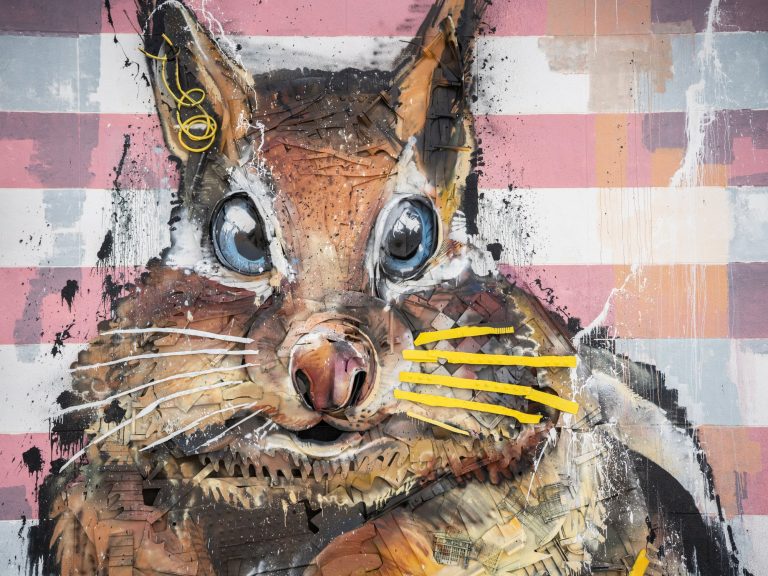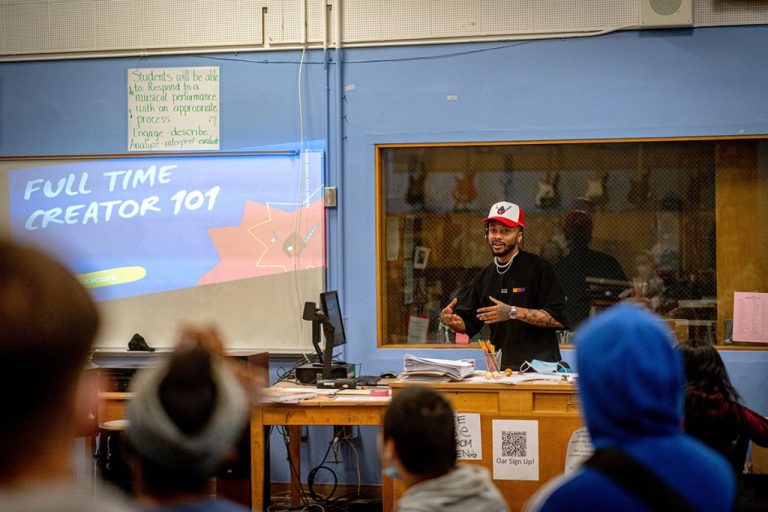The first quarter is a great time to reach out to your community of parents and local businesses to ask for donations. But have you considered other avenues to find and secure partnerships to benefit your art program? If you don’t know where to start, stick around for six steps to help you find and retain mutually beneficial stakeholders.

Today’s article is courtesy of Erin Saladino’s expertise. Erin is a Learning Experience Designer with AOEU. She brings her 17+ years of experience as a visual art and theater teacher and county art supervisor to the table.
If you are looking for more resources as you build relationships and influential communities, enroll in our two courses, Ethics and Equity for Art Education and Principles of Art and Business. You will be empowered to make small-scale changes in your classroom and program to bring learning opportunities to the next level. Get in touch with an admissions counselor today to discuss your personal goals and art room needs!
Get in touch with an admissions counselor!
What is a stakeholder, and what can they provide?
Before we dive into the steps of how to get a stakeholder to invest in your program, let’s first define what a stakeholder is. Erin describes a stakeholder as “anyone who can make an impact on your program through a basic need.” This can be the immediate community or your PTA, but take a moment to broaden the scope. Stakeholders can also be administration, institutions, parents or other family members, educational peers, and more.
Now that we have established who stakeholders can be, consider what they can provide to your art program. This can be more than just supplies or financial donations. Stakeholders can donate a venue, a workshop, or volunteer time. Check out this article on reaching out to local artists and this one on partnering with a museum.
Here are six easy steps to get started with stakeholders.
1. Identify your need.
Before you can effectively target who to look for, figure out what you and your students need to grow. Do you need volunteers to help you hang a huge end-of-year art show? Do you need professional development to become more tech-savvy? Do you need a space to host a family art night? Or do you need specialized supplies to teach a lesson in your curriculum? It is important to determine your specific need so you know who and how to ask.

- How to build a website with WordPress and what are the best plugins to use Building a website with WordPress is an excellent choice due to its versatility, ease of use, and a vast array of plugins that enhance functionality. Here’s a comprehensive guide to building a WordPress website, along with recommendations for the best plugins
- Top WordPress Plugins for Managing Ads and Monetizing Your Website Effectively: Why is Ads Management Important for Website Monetization? Strategic ad placement throughout the website enables publishers to maximize ad revenue while ensuring a positive user experience. The positioning of ads is critical in capturing users’ attention without being intrusive or disruptive. By understanding user behavior and preferences, publishers can make informed decisions regarding ad placement to ensure that the ads are relevant and engaging.
- Top Directory Plugins for WordPress to Create Professional Listings and Directories: If you are interested in establishing professional listings and directories on your WordPress website, the following information will be of value to you. This article will present the top directory plugins available for WordPress, which include GeoDirectory, Business Directory Plugin, Sabai Directory, Connections Business Directory, and Advanced Classifieds & Directory Pro.
- The Most Important Stages and Plugins for WordPress Website Development: Developing a WordPress website requires careful planning, execution, and optimisation to ensure it is functional, user-friendly, and effective. The process can be broken into key stages, and each stage benefits from specific plugins to enhance functionality and performance. Here’s a detailed guide to the most important stages of WordPress website development and the essential plugins for each stage.
- .org vs .com: A Top Guide to the Differences in Domain Extension
When you set up a website for a business or a non-profit organisation, you might think the most important part of the address is the actual name. But the domain extension (the bit that comes after the dot) is just as important for telling people what your site is all about. - The Best WordPress Plugins for Image Optimization to Improve Load Times and SEO. The pivotal element lies in image optimization. This discourse delves into the significance of image optimization for websites and its impact on load times. Furthermore, we will delve into the advantages of leveraging WordPress plugins for image optimization, such as streamlined optimization processes, enhanced SEO, expedited load times, and an enriched user experience.
- What is a data center or Internet data center? The term “data center” has become very common due to the role it plays in many of our daily activities. Most of the data we receive and send through our mobile phones, tablets and computers ends up stored in these data centers — which many people refer to as “the Cloud”, in a more generic way.
2. Find stakeholders.
Look back at the need you established. What group or party can best meet that need? Think outside of the box. Technology has made it easier to connect with people outside of your immediate local community.
For example, if you need professional development to improve your classroom management skills, here are some stakeholders you can consider:
- Parents and Caregivers
Reach out to parents, caregivers, or even adult family members. These stakeholders can be your art assistants for a class period or day. They love to see first-hand what happens in your classroom! - Community Organizations
Local groups like your PTSA, a church, or a community center can also volunteer their time to help with family art nights or your end-of-the-year art show. - Colleagues
Ask some veteran teachers you admire in your school building if you can sit in and observe their teaching during your planning period. These can be core content teachers or other art teachers. - Administration
Identify classroom management as a need on your end-of-year evaluation or formal observations. Request for administration to pay for on-demand PD videos through PRO or enroll you in our graduate course, Managing the Art Room. The administration can be at the school or district level or both. - Virtual Colleagues
Perhaps you connect with some art teachers across the country through an art teachers’ social media group. Try a pen pal experience where you message back and forth. Hop on a video call to observe them teaching live in their classroom during your planning period, or have them record themselves for you to learn from later.
You may be wondering how many stakeholders to ask. It’s a balancing act! Erin recommends throwing out lots of lines and seeing who grabs. Just remember, you don’t have to work with every stakeholder who says yes. Don’t settle because you have a stakeholder willing to meet your need. Research each stakeholder to ensure they are a reputable organization or party you would be proud to partner with. Out of those who said yes, which one(s) would be best able to meet your particular need? Another way to learn how to find stakeholders is to take our course, Advocating for the Visual Arts.
3. Create an authentic pitch.
How you ask is very important. Come up with an elevator pitch or speech you can “cut and paste” to your stakeholders. Take an extra couple of minutes to customize your pitch to each recipient. This should be a short (thirty seconds) spiel to introduce you and your students, the need, and how their partnership will be mutually beneficial.
Here is a recipe for the perfect elevator speech:
- Who am I?
Introduce yourself, where you teach, and, as Erin puts it, “what makes you sparkle!” Share what makes you and your art program authentically unique. - What do my students or I need?
Explain the need at hand and how it will benefit you or your students. It is also important to tell them how it will benefit them and the community at large. - What’s my ask?
Give the stakeholder a call to action. Be clear about what you are requesting from them so they can make an informed decision.
Here’s an example of an elevator speech to a clothing department store with a need for mannequins:
Hi! I’m Lindsey McGinnis, a high school art teacher outside of Baltimore, MD. I am passionate about fiber arts and getting students engaged with this hands-on art form. I’d love to get some mannequins to use as dress forms. I’d also love to use them to showcase garments at the culmination of our Wearable Art unit in a display in one of your storefront windows. We will have a small reception in your store, which will increase traffic and bring in new customers. We will also share the event with your name on our school and classroom social media platforms. Do you have six mannequins we can either borrow or keep for this unit and future projects? Can we display student garments in one of your storefront windows for one month and host a reception in your store?

4. Reach out with your packaged pitch.
Design promotional materials to include all of the elements of your elevator speech. Promotional materials can be mailed brochures or a fancy email with an embedded video. Reach out to your identified stakeholders with your package. Be sure to customize each package and highlight how it will specifically benefit them.
Whatever your format and end product, share your go-to communication platform so stakeholders can connect with you and learn more. This can be a school or class website or a social media platform. Instagram is a popular platform for art teachers because of its visual nature, but Erin says not to discount Twitter. On Twitter, you can share and get responses more quickly. Twitter also makes it more convenient to share links directly with viewers. TikTok is a newer platform of choice for many art teachers. Erin cautions that there may be too many students there, which can complicate posting and interacting.
Whatever social media platform you decide to use, here are some guidelines to keep in mind:
- Know your district and school’s policies and adhere to them.
- Be intentional about your messaging and word choice.
Use your student demographics as a strength, and use words and images that cast them in a positive light. Even the most well-intentioned of us can hurt more than help, so focus on the benefits and impact of meeting the need versus the need itself. In other words, prioritize building up in lieu of begging. - Create separate personal and professional accounts.
Just as you should take time to investigate your stakeholders, they will do the same for you. Be mindful of what you share on the internet, and take extra precautions to block your personal account from your professional account. This will eliminate as much connection and linkage as possible. Stakeholders don’t just invest in your program but also in you because you are the face of your program! Things online can easily be taken out of context, so do not let a small personal detail deter a stakeholder from pouring into your students. Stakeholders also talk to each other, so this can be a way to foster future connections. - Represent yourself and your students authentically.
Social media tends to be a highlight reel. Be yourself and share what makes you and your students “sparkle!”

Share any other fundraising links you may have with potential stakeholders. Examples are Donors Choose, Amazon Wishlist, or Go Fund Me. You can also proactively post your promotional package and communication platforms on your district or school’s website as well as your city or town’s website and local arts council’s page. If you have a LinkedIn account, set your profile to advertise and add appropriate tags for those looking for causes to support. Contact your district’s grant writing department for other platforms and opportunities. Larger districts usually have a department, and smaller districts usually have one administrator or teacher specializing in this area. Grant writing teams will often have resources to share and may even reach out on your behalf.
5. Be transparent during the process.
This should be a symbiotic relationship and not one where you simply receive support. Consider what benefits this relationship can provide to your generous stakeholder. They may not be in it for anything other than offering a helping hand. However, if there are ways you or your program can support them in any way, why not? Be transparent with your stakeholders during every step of the process. Share what your students are working on and communicate what you are doing.
6. Say, “Thank you!”
Erin says, “Sending a thank-you note like your momma taught you goes a long way!” Tap into your creativity to send a fun thank-you note from your students. Stakeholders deserve recognition. Take additional steps to publicly thank them by tagging them on social media and putting their name and logo on your website and promotional materials. Be specific with your thank-you notes, and share the impact they made with their contribution.

“Stakeholder” can be an intimidating word. Hopefully, this article unpacked what a stakeholder is and made the process of getting stakeholders to support your art program more tangible. Partner with others to grow your teaching practice and repertoire and bring new curricular experiences to your students. Establish a specific need, identify stakeholders who can meet the need, and reach out to them with a carefully crafted elevator pitch. Wrap up the process well with transparency and recognition. Then, revel in the positive impact you have made on your students’ learning, your art program, and your newfound community relationships.
What questions do you still have about working with stakeholders?
Share a cool story about a partnership that benefitted your art program.





